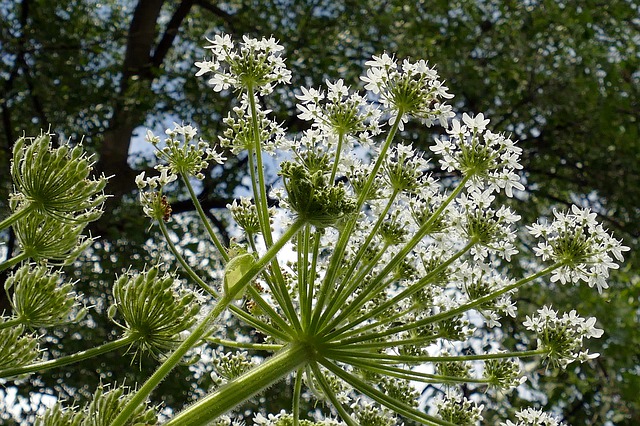
 |  |   |   |  |
 |  |
The
Hogweed
family includes biennial plants, rarely perennial plants with strong, spike-shaped roots and grooved, hollow, upright stems. Some representatives of this family can reach up to 6 m in height. The large and split leaves tend to be 20-60cm long and 20-30cm wide. Leaves on the same plant can look different. At the beginning of spring, tripartite leaves appear at the base of the stem, with almost one-piece parts. The younger the leaves, the bigger their split and the leaves of the stem are already divided into two or three parts with large, narrow, toothed parts.
During growth, the
Hogweed
plant changes its leaves again, only then they do not become more complex, but on the contrary - simpler.
The flowers of
Hogweed
are small, regular, white, greenish-yellow or pinkish, collected in large, complex compound cymes, where the central ray is significantly larger than the outer ones. The flowers in the central cyme are bisexual, the lateral cymes are usually sterile.
Siberian
Hogweed
(Heracleum sibiricum) - perennial, densely hairy plant, 0.8-1.5m in height. The large leaves are divided into 3-7 wide oval parts. Upper leaves on long stems, lower ones practically sessile. The flowers are small, greenish yellow, collected in a cyme, the diameter of which is on average 15 cm. 15-30 rays in the central face, 20-50 in the side.
Sosnowski Hogweed
(Heracleum sosnowskyi) - a perennial plant, up to 2 m tall. It has a hairy stem and large, rough leaves. The leaves of Sosnovska
Hogweed
are divided into 3-7 oval parts. The flowers are small, white, collected in large clusters. The central cone reaches a size of up to 40 cm in diameter.
Mantegaca
Hogweed
(Heracleum mantegazzianum) - brought to Latvia as a flowering plant and rarely found. It is one of the most gigantic representatives of its family. Often it can reach up to 6m in height. Stem erect with glandular hairs. The upper leaves are sessile, with large, inflated sheaths at the base, the lower leaves on long petioles. Both the stem and the lower petioles are often covered with red spots. The flowers are white, collected in large clusters up to 1 m in diameter.
The following
Hogweed
are collected for medicinal purposes: Sosnovska
Hogweed
(Heracleum sosnowskyi), Siberian
Hogweed
(Heracleum sibiricum) and others, but they are not found in Latvia. The leaves and stems are harvested during flowering of the
Hogweed
and dried in well-ventilated rooms. The roots are dug in autumn, when the surface part has died. The dug rhizomes are similar to a huge carrot, they are cleaned from the soil, rinsed in running water and cut into pieces. Place the pieces in a single layer to dry in a well-ventilated place. Just don't forget that Sosnovska
Hogweed
is a dangerous plant and can cause harm.
Medicinal significance
The medicinal value for Hogweed began to be studied only at the beginning of the 21st century and the conducted experiments determined its antispasmodic, anticonvulsant, astringent, anti-inflammatory, pain-relieving, antiseptic and antibacterial properties - extracts of various Hogweed were tested.
A large number of Hogweed species are used in folk medicine. The juice of various Hogweed was used to treat festering wounds and ulcers.
Decoctions of Sosnovska Hogweed are mainly used externally. It treats skin itching, neurodermatitis, eczema, gout and rheumatism. In the form of compresses, it is used to treat scabies and various skin rashes. In rare cases, a diluted decoction is used to rinse the mouth and throat, catarrhal angina, gingivitis and stomatitis.
Siberian Hogweed has gained wide application in folk medicine. It treats hypersthenic neurasthenia, epilepsy, convulsions, hysteria, chymacteric syndrome, chronic enteritis, colitis, chronic gastritis with secretory insufficiency, algodysmenorrhea.
Its decoction is drunk to stimulate the appetite, as a digestive and as an antispasmodic, astringent in diarrhea and dysentery. A decoction of the roots is used for gallstones, kidney diseases, convulsions, epilepsy, bronchial asthma and skin itching.
In case of eczema and neurodermatitis, the plant is used both internally and externally. On the other hand, in case of stomatitis, catarrhal angina and gingivitis, only externally. The infusion of the seeds of the Siberian Hogweed is used against stomach spasms and hysterical attacks, liver and gall bladder diseases, jaundice. It is also used in uterine diseases, epilepsy and dyspnoea. There is a belief that by fumigating rooms with Siberian Hogweed seeds, excessive sleepiness disappears and the person becomes more active.
Mixing the juice of the Siberian Hogweed with vegetable oil and rubbing it into the scalp relieves headaches and lethargy.